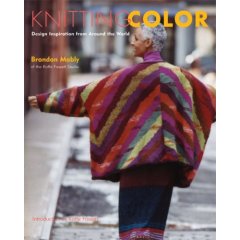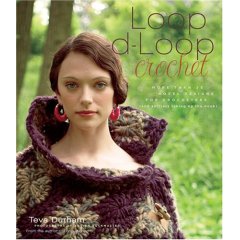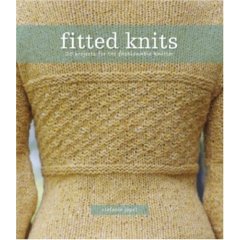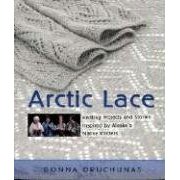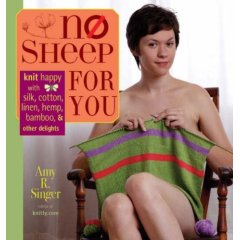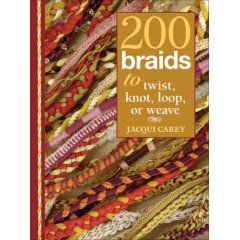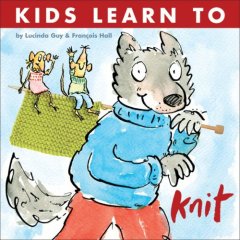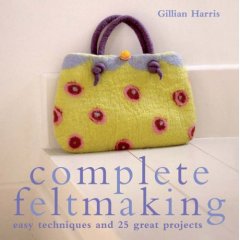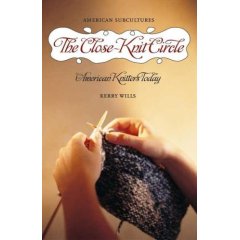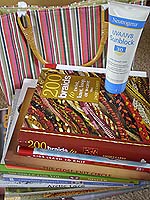
On the Shelf:
Nine Summer Knitting Titles
When it gets too hot to comfortably knit, why not read about knitting instead? I've gone through my rapidly growing library of books and picked some titles you may enjoy. Most are new, and a few have been around longer but are too good to pass up. Happy reading!
We begin with a big, beautiful book from Brandon Mably. I'm tempted to call it a coffee-table book because its glossy pages are filled with lush and evocative photographs from Mably's travels around the world—places like Vietnam, Peru, India, South Africa, and even the United States.
But that doesn't entirely do this book justice because it's also a full-fledged book about color inspiration in knitwear design—a subject Mably knows well. He begins with an abbreviated color workshop and then launches into his travels, showing photographs of places and then presenting the knitted design that was inspired by that image. It's genuine, not contrived, and I love to see how he translates what he sees into what he knits.
There are 20 patterns total, with several jackets and pillows as well as wraps, vests, and other objects. It's a great book for armchair travel and dreaming.
by Teva DurhamI can't discuss beautiful books without mentioning Teva Durham's new ode to crochet. Her earlier book, Loop-d-Loop, fed the knitting world with bold, modern styles that showed respectful roots in traditional knitting.
A self-professed "knit snob," Durham admits that she viewed crochet as the "poor stepsister to knitting" until she discovered an exquisite crochet piece made by her grandmother. Having learned that crochet was firmly rooted in her own crafting heritage, Durham set herself on a mission to learn more about crochet. "It was like free-falling into a new dimension at first," she writes, but soon she began to contemplate the design potential in front of her. This book is the result of that mission.
The designs all carry Teva's distinct outside-of-the-box style aesthetic, with bold and modern shapes, colors, and textures. The photography is evocative with designs unlike any crochet work I've ever seen.
by Stefanie JapelSpeaking of evocative designs, Stefanie Japel—the woman behind Glampyre Knits—has recently published a book of her own original designs. In keeping with the "fitted knits" title, Japel starts out with a very brief three-page explanation about how you can use minor calculations to adjust each of the book's 25 patterns for an ideal fit. I like this, because it means I could knit almost everything in this book and know that it'd fit me just right.
The designs are presented by garment type—tubes, tanks, and tees; shrugs, cardigans, and wraps; sweaters, vests, and coats; and dress-up clothes. Part of what makes Japel's customizing-to-fit instructions work is the fact that all the projects in this book—that is, all those with substantial sleeves—have a raglan shaping. If you're a decidedly anti-raglan kind of knitter, you may not be best served by this book. As for me, my heart has been won by the Textured Tunic pattern shown in detail on the cover.
by Donna DruchunasWhile summer may not be the best time to work with qiviut—it is the warmest fiber on the planet after all—it is the perfect time to read about it. And nobody has done qiviut more justice than Donna Druchunas in this award-winning book.
Druchunas leaves no stone unturned in her quest to find out everything there is to know about qiviut and the cultural knitting traditions surrounding it. She begins with the story of the Oomingmak Musk Ox Producers' Co-operative and the Native Alaskan women who own and operate it, taking us to several regions and showing the traditional lace pattern from each area. We meet the mythical musk ox and learn just how much work has gone into developing the qiviut yarn you see today.
Then she puts knitting needles back in our hands and teaches us how to knit lace, from choosing needles and casting on to reading charts to working the basic lace stitches. You have three swatch lessons, and then a tutorial on blocking your qiviut project to perfection.
Here's where I should start yelling, "But wait, that's not all—it also comes with a free set of Ginsu knives!" Because in addition to the wonderful history, geography, and culture lesson, Druchunas next presents 20 of her own original designs inspired by the culture and art of the Yup'ik and Inupiat people. They range in skill from relative beginner to advanced knitter, and all are of a reasonable size (which is good because qiviut also happens to be one of the most expensive fibers on the planet). And after showing you her patterns for things like scarves, hats, wrist warmers, and so on, she finally gives you helpful information on how to create your own design.
It comes as no surprise that this book won the Bronze Medal in the Independent Publisher Award contest at this year's Book Expo America.
by Amy SingerIf the mere notion of reading about warm fibers has you down, Amy Singer's anti-wool manifesto will come in handy. Allergic to wool, Singer has focused her knitterly mind on the subject of wool alternatives. These materials have come a long way since the early days of sticky synthetics. "The fibers we knit with may not all be natural miracles like wool," she tells her fellow non-wool knitters, "but thanks to science and technology, they're still a miracle and are totally knitworthy for their own merits."
In a chatty and conversational tone, she walks you through the qualities of different non-wool fiber types, such as cotton, linen, hemp, silk, bamboo, soy, and so on. But even she shudders at polyester, describing it as "like that creepy relative of yours that won't go home after the family reunion." More helpful fiber tidbits are tucked throughout the rest of the book.
In terms of pattern selection, Singer has assembled a variety of garments, many of which you'd expect to be knit in wool—intricate cabled and colorwork pullovers, and even socks and thrummed mittens.
by Jacqui CareyIf you have fond memories of making lanyards in summer camp, this book is for you. I don't know what you'll actually do with the miles of braided, twisted, knotted, looped, and woven stuff you'll end up making. That part is up to you—perhaps funky shoelaces, or bag handles, hair accessories, curtain tie-backs, or even embellishments that you sew onto knitted items. I know I'll bring this book out when my young nieces come to visit later this month.
by Lucinda Guy and François HallSpeaking of young nieces, if you find yourself trying to entertain kids on summer vacation, perhaps it's time to teach them how to knit? Better yet, hand them a book, some yarn and needles, and let them teach themselves.
Ha! I realize that's easier said than done. But if you know a patient and self-directed five- to ten-year-old who wants to knit, this would be a great book to give him or her. It's well-written and clear without being intimidating. The illustrations and pictures and even projects follow the same style as Guy and Hall's previous knitting books—Mary Poppins meets Amelia Bedelia, but in a knitting context.
by Gillian HarrisIf you're in an arts-and-crafts mood but need a little more fiber contact than lanyards, consider making this your summer of felt. We have a lot of good felt books on the market right now, including a lovely new one from Nicki Epstein, but this softcover book from Gillian Harris probably remains the most technically varied and visually gorgeous one I've seen.
The cover picture alone was enough to hook me, but look inside and you'll find page after page of more projects that are just as fresh and attractive. Techniques include flat felt (with an adorable "Ewe and I" sheep wallhanging for beginners), three-dimensional shapes (such as the bag on the cover), knitted felting (including a fun chair cushion), needle felting (with the most adorable tooth fairy bag I've ever seen), and so-called "advanced" techniques, such as nuno felting. Each technique is clearly explained and illustrated, and each pattern has a difficulty rating to help you choose what to do next.
by Kerry WillsIn my dream world, universities would offer degree programs in knitting. The well-rounded curriculum would span not just fibers, yarns, and techniques, but also history and culture. And in the latter category, Wills' book would be one of the textbooks.
With the persistence of an investigative reporter and the passion of a Ph.D. candidate, Wills walks us through her own snapshot of the contemporary knitting world. She does so primarily through interviews with dozens upon dozens of knitters, from knitters to shop owners, prominent knitbloggers, designers, and authors. She goes all over the place, from the influence of Elizabeth Zimmermann to Kate Gilbert and her famous Clapotis. She ends her book with a quote from Stephanie Pearl-McPhee, from whom the book's title was taken.
Wills does an admirable job of capturing one slice of our broad and ever-shifting knitting ecosystem into just a little over 100 pages. The textbook feel is enhanced by the book's formal black-and-white layout, high price tag, and the fact that it doesn't come to us from a knitting publisher at all. Rather, it is part of Praeger Publishers' American Subcultures series.




